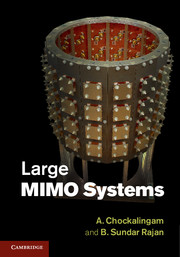Book contents
- Frontmatter
- Dedication
- Contents
- Preface
- Acknowledgments
- Abbreviations
- Notation
- 1 Introduction
- 2 Large MIMO systems
- 3 MIMO encoding
- 4 MIMO detection
- 5 Detection based on local search
- 6 Detection based on probabilistic data association (PDA)
- 7 Detection/decoding based on message passing on graphical models
- 8 Detection based on MCMC techniques
- 9 Channel estimation in large MIMO systems
- 10 Precoding in large MIMO systems
- 11 MIMO channel models
- 12 Large MIMO testbeds
- Author index
- Subject index
- References
10 - Precoding in large MIMO systems
Published online by Cambridge University Press: 18 December 2013
- Frontmatter
- Dedication
- Contents
- Preface
- Acknowledgments
- Abbreviations
- Notation
- 1 Introduction
- 2 Large MIMO systems
- 3 MIMO encoding
- 4 MIMO detection
- 5 Detection based on local search
- 6 Detection based on probabilistic data association (PDA)
- 7 Detection/decoding based on message passing on graphical models
- 8 Detection based on MCMC techniques
- 9 Channel estimation in large MIMO systems
- 10 Precoding in large MIMO systems
- 11 MIMO channel models
- 12 Large MIMO testbeds
- Author index
- Subject index
- References
Summary
Channel state information at the transmitter (CSIT) can be exploited to improve performance in MIMO wireless systems through a precoding operation at the transmitter. Precoding techniques use CSIT to encode the information symbols into transmit vectors. Typically, an information symbol vector u is encoded into a transmit vector x using the transformation x = Tu, where T is referred to as the precoding matrix. The precoding matrix T is chosen based on the available CSIT. Precoding on point-to-point MIMO links and multiuser MIMO links is common. In addition, multiuser MIMO precoding in multicell scenarios is of interest. In this chapter, precoding schemes for large MIMO systems are considered.
Precoding in point-to-point MIMO
In point-to-point MIMO links, precoding techniques can achieve improved performance in terms of enhanced communication reliability, which is typically quantified in terms of the diversity gain/order achieved by the precoding scheme. In addition to performance, precoding/decoding complexities are also of interest. Often, one encounters a tradeoff between performance (diversity gain) and precoding/decoding complexity. Well-known precoders for point-to-point MIMO are presented in the following subsections.
System model
Consider an nt × nr point-to-point MIMO system (nr ≤ nt), where nt and nr denote the number of transmit and receive antennas, respectively. Assume CSI to be known perfectly at both the transmitter and the receiver. Let x = (x1,…,xnt)T be the vector of symbols transmitted by the nt transmit antennas in one channel use.
Information
- Type
- Chapter
- Information
- Large MIMO Systems , pp. 219 - 250Publisher: Cambridge University PressPrint publication year: 2014
